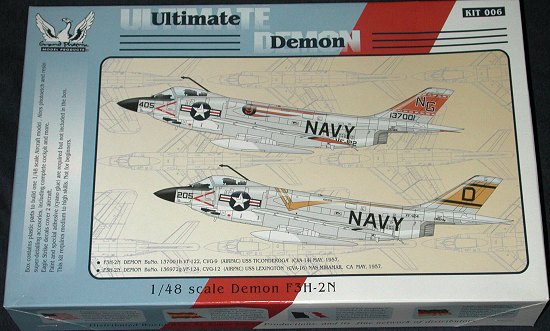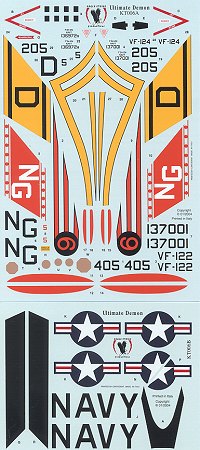
| KIT: | Grand Phoenix 1/48 F3H-2N Demon |
| KIT #: | 006 |
| PRICE: | $69.95 MSRP |
| DECALS: | Two options |
| REVIEWER: | Scott Van Aken |
| NOTES: | Multimedia kit with resin and photo etched parts. |

| HISTORY |
The McDonnell F3H Demon was a US Navy carrier-based jet fighter aircraft. The successor to the F2H Banshee, after initial problems, it served from 1956 until 1964. Development work began in 1949, the aircraft was designed around only a single Westinghouse Electric Corporation J-40 engine, which was to have over 11,000 lb of thrust - three times that of the engines in the Banshee. It was the first swept-wing design produced by McDonnell and among the first US aircraft to have missile armament.
The prototype first flew in 1951 and first test flights of the operational design were in January 1953. The engine was a major disappointment, producing only half of the expected power it was temperamental and unreliable, of 35 F3H-1 aircraft that were flown with the J-40 engine eight were involved in major accidents. The J-40 engined aircraft were grounded and a new engine was sought. (In fact, brand new J-40 powered Demons were barged or trucked directly to training schools and never flown, starting an investigation into fraud by members of Congress. Things never change.) The best alternative was destined for the F-100 Super Sabre and subsequent F3Hs were fitted with the Allison J-71 engine (also used in the B-66) and designated the F3H-2. While more reliable this new engine had to be 'shoe-horned' into the airframe and with less power than needed did little for the aircraft's performance.
The first Demon with a J-71 flew in October 1954. Another problem was with the ejector seats, initial versions could fail to operate and had to be replaced with Martin Baker models. Despite the problems in 1956 the Navy ordered 239 F3H-2s and the first were deployed in March 1956. 522 Demons of all versions were built up to the end of production in November 1959. It was the Navy's first all-weather interceptor with radar and the Raytheon Sparrow or Sidewinder AAM and remained the Navy's front-line fighter until 1962 when it was succeeded by the F-4 Phantom II. Although developed during the Korean War it did not see action, although it flew over Lebanon and Quemoy in 1958. Pilots I've spoken to who flew the later F3Hs were full of praise over its dog-fighting capabilities. With the more powerful engine, the aircraft was a delight to fly, though still rather short-legged.
| THE KIT |

 Many
of us are fans of aircraft of the 1950's US Navy and it was with a great
deal of anticipation that I awaited this Demon kit. Finally, we get a 1/48
scale version and it is a beauty. Upon opening the box, you'll first notice
that it is just crammed full of goodies. The injected parts are very well
detailed with nicely engraved panel lines. The parts are flash free, though
I did find somewhat thick mold seams on the nose gear. A few sink areas
were found as well, but are in areas where it will be easy to fix. All of
the large pieces have ejector towers that will have to be dealt with as
well, but again, these are going to be easy to remove. It is just the
nature of the beast. A very clear windscreen and canopy are also provided
(not shown) so that you can display
Many
of us are fans of aircraft of the 1950's US Navy and it was with a great
deal of anticipation that I awaited this Demon kit. Finally, we get a 1/48
scale version and it is a beauty. Upon opening the box, you'll first notice
that it is just crammed full of goodies. The injected parts are very well
detailed with nicely engraved panel lines. The parts are flash free, though
I did find somewhat thick mold seams on the nose gear. A few sink areas
were found as well, but are in areas where it will be easy to fix. All of
the large pieces have ejector towers that will have to be dealt with as
well, but again, these are going to be easy to remove. It is just the
nature of the beast. A very clear windscreen and canopy are also provided
(not shown) so that you can display
 all
the detail in the cockpit.
all
the detail in the cockpit.
There are two bags full of Aries
resin parts and these comprise most of the fine detail parts. Amongst them
are the wheels, speed brakes, wheel wells, engine exhaust and afterburner
can, cockpit tub, ejector seat, control stick, tail hook and a myriad of
other bits and pieces. To add to the fine resin is a nice etched fret that
is limited to things like the instrument panel, wing brakes,
 wing
fences, shoulder harness and a detail part for the burner can. Not shown is
a set of canopy and wheel masks that appear to have been done by Eduard.
There is also an acetate film for the instruments and gun sight glass.
wing
fences, shoulder harness and a detail part for the burner can. Not shown is
a set of canopy and wheel masks that appear to have been done by Eduard.
There is also an acetate film for the instruments and gun sight glass.
The instructions are very well done. In addition to the nicely drawn construction steps and info drawings, complete color information is provided, though only generic names are given in the painting chart. I should mention that for the interior, Dark Gull Grey is probably the grey to use as that was a common color when the Navy went to the Light Gull Grey over White scheme. This kit is of the gun version of the Demon and so does not supply any wing pylons or missiles. Two fuselage mounted drop tanks are supplied should you wish to use them. Markings are provided for two aircraft and they are both quite colorful. One is from VF-122 aboard the USS Ticonderoga in 1957 and the other is for VF-124, aboard the USS Lexington during the same period of time. The decals are superbly done by Eagle Strike and printed by Cartograf. Choosing which one to do will be most difficult!
| CONCLUSIONS |
If you have always wanted a 1/48 Demon, then this is the kit to have. There is no need to have to buy aftermarket bits as everything you'll need is included in this most impressive kit. Since this is a limited run kit, I recommend getting yours while the getting is good.
 Thanks to
Grand Phoenix for the review kit.
Thanks to
Grand Phoenix for the review kit.
If you would like your product reviewed fairly and quickly by a site that has over 250,000 visitors a month, please contact me or see other details in the Note to Contributors.